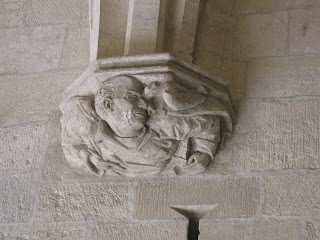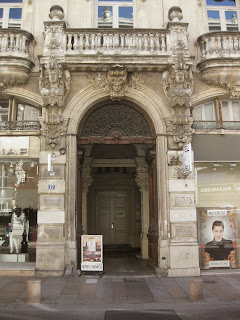From the time more than 40 years ago
when I first heard the song and learned what the words meant, I have wanted to
come here and see the bridge. Then I learned that most of it had fallen down
centuries ago. That’s all right, so did London Bridge, and I crossed the ocean
to see that.
If you’re old like me you pay 11 euro
for one ticket that gets you onto the bridge and also into the Palace of the
Popes. Quelque chose! a bargain.
And it was an all-day trip. We left
the hotel around noon and went to the post office because I had a couple of
cards to mail to the States.
The post office is right by one of
the city gates. The walls run all around Avignon. They are largely intact, but
in bad repair. People aren’t allowed to walk on them because some of the stones
are loose. You could fall, or knock one down on somebody’s head.
Many of the old stone walls here are
made of limestone or sandstone, or maybe chalk and butter. I’m not sure. In the
Palace of the Popes, Joanna brushed against a wall when she was trying to take
a picture, and there was white dust all over her trenchcoat.
Many walls have deep holes where the
stone has dissolved in the wind and the rain. I put my fingers into one stone
and some grains came away. It was upsetting. Oh no, I just took six months off
the life of somebody’s house.
In fact, the window of my room looks
out on some ancient-looking stone walls. You can see where a piece of one of
them fell and lodged in the roof of an adjoining building. Now, if that
happened in New York, or maybe anywhere in the States, there would be a dozen
hungry lawyers trying to find out who owns the roof and how much they can get.
The bridge that stands in the Rhone
now consists of four arches. There used to be more than 20. The original bridge
was the inspiration of someone named St. Benezet. He raised money in the 12th
or 13th century and roused people to build it.
The Rhone at this stage outweighed medieval
bridge work by a good measure, so the thing kept falling down. It was abandoned
in the 17th century. The last remaining arches were restored in the 19th or
20th century and are now part of the Unesco World Heritage Site at Avignon. The
papal palace and a couple of other things are also part of that.
It is made of blocks of stone and is
paved with a difficult surface of river stone laid in concrete. Think of round
bulbous things poking up to torture you.
Joanna says this kind of surface is
recommended for reflexology. If you walk on the surface in your bare feet, it
makes you healthy. I walked on that pavement in my long-distance shoes, a pair
of rubber-soled Rockports, and those stones took some work.
I have learned on this trip that the
Rhone was the border between France and somewhere else. The popes lived on this
side and Philip the Fair had the other. the bridge was heavily protected on
both sides. There’s something, the tower of Philippe le Bel on the far side of
the Rhone. The Avignon side includes a drawbridge.
I suddenly remembered my Monty
Python. Imagine a bunch of French guys running across the bridge shaking their
swords. The drawbridge goes up. They fall into the river. The pope is on the
wall saying, “Aha, you silly French persons, your father is a hamster and your
mother smells of elderberries. I fart in your general direction.” Or words to that
effect.
I’m sure that Matt, who has the movie
memorized, can give me the correct dialogue.
When we came to the end of the current bridgework, Joanna got a cool shot of our shadows in the water. There we are on the Rhone.
We left the bridge and climbed a tower to see if it led to the palace. It didn't, but that's all right. You can see why.
We backtracked and wandered toward the plaza where they actually let you into the palace. It was 2 o’clock by then and I hadn’t had wine all day. But there is always a cafe when you need one. I was able to order a cheese plate with bread and a glass of white Cotes du Rhone.
We left the bridge and climbed a tower to see if it led to the palace. It didn't, but that's all right. You can see why.
We backtracked and wandered toward the plaza where they actually let you into the palace. It was 2 o’clock by then and I hadn’t had wine all day. But there is always a cafe when you need one. I was able to order a cheese plate with bread and a glass of white Cotes du Rhone.
There were two soft cheeses and one
hard, served with a fig and some tapenade, probably egg plant. This white was very
interesting with the cheese. It had several fruity and sometimes even mineral
flavors, and they changed depending on the type of cheese I had just eaten. I
think Joanna noticed that too.
After lunch, we climbed a steep alley
of stairs and came out into the plaza of Le Palais des Papes.
The palace has wings inside wings,
and there used to be more. After the Revolution it was adapted to serve as an
army barracks and several structures were torn down.
I think the place was planned to be
confusing, to control housebreakers and assassins. Unless you were an insider
and knew your way around it, you would get lost in there and starve.
We followed the tour circuit because
there were signs pointing the way, but I had no idea where we really were at
any time inside the palace.
It is fascinating even now with the
furnishings gone. Some rooms, like the papal apartment, have period furniture,
but the pieces are not original to the house.
Many rooms—and this I found
astonishing—are still covered with vivid painting from the 1330s. Chaucer
really was a boy then. The pope’s room is decorated with a tracery of vines
with birds and small animals hidden in the motif. The recesses for the windows
are painted with trellises and trefoil arches so they look like corridors or alleyways.
It’s very amusing stuff, and
according to the notes, shows the influence of early Renaissance techniques
being developed in Italy at the time.
There is a chapel dedicated to John
the Evangelist and John the Baptist that is still very much preserved. In the
panel where they bring Salome the head of the Baptist on a charger, there is a
puppy standing next to her.
The consistory, where the pope met
the cardinals for official business, the chapel, and the dining hall are huge
spaces with Gothic vaulted ceilings.
There are displays of fragmentary
objects found during excavations on the grounds, often they are bits of stained
glass, or small ornaments. There is a pile of round stones in one corner
outside. They are bullets thrown by ballistas or trebuchets, or some other kind
of early artillery during various times when the palace was under siege.
One display includes fragments of the
pope’s artillery. That case also includes a human skull pierced by the quarrel
from a crossbow.
The tour lets out on the far side of
the palace, and so we wandered for a while through some very narrow, very old
streets.
We saw a drawing of the bridge of St.
Benezet somewhere in the day’s travels, and it shows the palace, and behind it
an open space with what appear to be windmills. They’re not going to fit any
windmills in the old city now. There is no room for sidewalks so you have to
watch for the cars and get up against the wall when they go by.
We headed back to the hotel for a
breather. Joanna took a nap. I opened the other bottle that we bought at Et Si
Bacchus Etait une Femme. The label says Les Tetes de Chats, Coteaux du
Giennois, 2007. It is bottled by Mathieu Coste, vigneron a Villemoison. I think
it’s form the Loire Valley. At least, that’s what the lady at the wine shop told
me.
A very interesting drink, it had an
almost spicy hot bite. If I remember what Larry told me, the Loire Valley sits
on a vast limestone formation that flavors the soil, the grapes, and so the
wine. I have sensed a pleasant mineral flavor in other Loire wines, but this
was different, and very good in its own way.
Later, for dinner, we retraced our
steps from the night before. On the way to New Ground, we had stopped in front
of another restaurant to look at the menu. The waiter opened the door for us.
We already had a reservation, so we told him “tomorrow.”
This was tomorrow. L’Hermitage is
tiny and the menu very short. It bills itself as Provencal.
We started with appetizers. The
terrine maison tout cochon was a mixture of onion, other stuff, and maybe pork.
It came in two parts, one on a thick slice of lettuce and the other on a cake
that may have been foie gras. Les oeufs mollet aux girolle were poached and the
yolk still runny, served in a bowl with a creamy sauce.
For dinner we had a filet of beef
with real French fries. The meat was not as tender as you’d expect in an
American restaurant, probably because the beef was grass fed, but that made it
taste even better.
Wine, for my record, was Domaine du
Coriancon by Francois Vallot, vigneron a Vinsobres. It was labeled “cru des
Cotes du Rhone” and was a blend of Grenache, syrah, and Mourvedre grapes.
Hot damn! Vive la Provence.
Oct. 12 My dear Grasshopper,
"Les oeufs mollet aux girolle
were poached and the yolk still runny, served in a bowl with a creamy
sauce."
Did you copy the name of that dish
correctly? I wasn't sure, so I did a Google translate: "the calf eggs with
chanterelles." If I remember my French, folks would use "oeufs l'agneau"
— the lamb eggs — as a polite way of saying one of my favorite dishes in
Morocco, lamb's testicles. Is it possible your eggs had no yolks at all, but
were indeed calf's testicles? Call me curious.
Larry
Oct. 12
Sorry to say, I'm pretty sure these
were hen's eggs, Sensei.
Had I the slightest clue that I was
eating anything even remotely like prairie oysters, you know I'd be bragging
about that.
These were soft white eggs, with a
runny yellow yolk. By the shape, I knew they were poached or cooked in a
similar way.
Grasshopper
Oct. 12
Hmmm...how did they come up with that
name for the dish? I will have to ask my friend Claude the next time I talk to
him
Larry
Oct. 13
I have a Collins translating
dictionary with me. The assumption that I have miscopied something in French is
always a good one.
This time, however, the dictionary
says “mollet” as a noun can indeed mean “calf” or “calf leg,” which of course I
didn't know until just now when I looked it up. The word's also an adjective
that means "softish" and that's where the dish name comes in.
Collins lists a special usage of “oeufs
mollets” as “soft-boiled eggs.” So these may have been soft-boiled and taken
out of the shell whole. Or maybe poached also counts.
Oct. 13
Mystery solved....nice work.
Larry



























